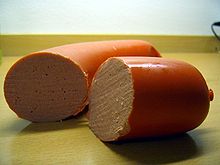Falukorv
Falukorv (Swedish korv - sausage) is a Swedish trademarked sausage .
According to tradition, she comes from Falun , which employed a large number of German miners in what was then Sweden's largest mine in the 16th and 17th centuries . Since steel ropes were not yet used in mining at that time, leather straps made of ox skin were used for the elevator cages in which the ore was carried to the surface. About 200 oxen had to be slaughtered to make a 150 m long rope. The workers from Germany came up with the idea of processing all the meat into sausage, which was then sold to Stockholm . The name Falukorv has been documented since 1830.
Falukorv in Swedish cuisine
Falukorv is traditionally eaten cut into thick slices and fried, with either macaroni or mashed potatoes . Raw and sliced the sausage is as cold cuts served on bread. A third common way to eat the sausage is as "Korv Stroganoff," a dish made with falukorv slices, onions and tomato sauce, inspired by the Bœuf Stroganoff .
The soft consistency of Falukorv is reminiscent of meat loaf . In Swedish families with children, dishes containing falukorv are regularly served.
The Swedish writer Hans Alfredson has her with the song Jag vill ha blommig falukorv till lunch, mamma! (I want flowery faluwurst for lunch, mom) a musical memorial was set up.
See also
Web links
- Information about Korv Stroganoff (Swedish)
- Via Korv Stroganoff, with recipe (Swedish)
